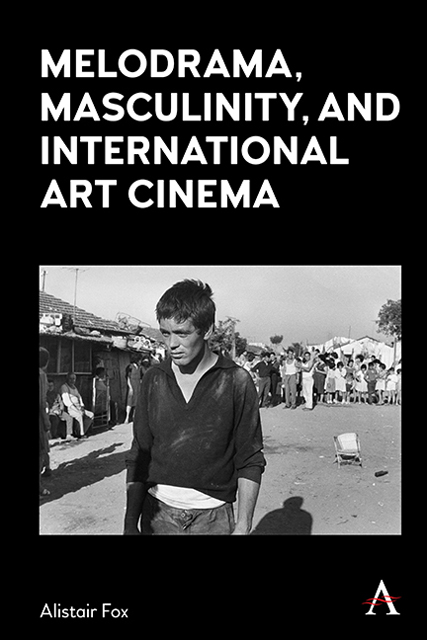Book contents
- Frontmatter
- Dedication
- Contents
- List of Figures
- Preface
- Acknowledgments
- Introduction
- Chapter 1 Italian Neorealism and the Emergence of the Male Melodrama: Vittorio De Sica’s Bicycle Thieves (1948) and Umberto D. (1952)
- Chapter 2 The Migration of Male Melodrama into Non-Western Cultures: Satyajit Ray’s The Apu Trilogy (1955–59) and “Fourth Cinema”
- Chapter 3 Hollywood Melodrama as a Vehicle for Self-Projection: Vincente Minnelli’s Tea and Sympathy (1956) and Home from the Hill (1960)
- Chapter 4 The Political Turns Personal: Neo-Neorealism and Pier Paolo Pasolini’s Accattone (1961)
- Chapter 5 Personal Cinema as Psychodrama: Ingmar Bergman’s Wild Strawberries (1957), Winter Light (1963) and Hour of the Wolf (1968)
- Chapter 6 François Truffaut and the Tyranny of Romantic Obsession: The Soft Skin (1964), Mississippi Mermaid (1969) and The Woman Next Door (1981)
- Chapter 7 Figuring an Authorial Fantasmatic: Jacques Demy’s The Umbrellas of Cherbourg (1964), A Room In Town (1982) and Parking (1985)
- Chapter 8 Rainer Werner Fassbinder and the Emergence of Queer Cinema: The Merchant of Four Seasons (1972), Fox and His Friends (1975) and In a Year with 13 Moons (1978)
- Chapter 9 Visual Aestheticism and the Queer Prestige Melodrama: Call Me by Your Name (2017) and Luca Guadagnino’s Desire Trilogy
- Conclusion
- List of Films Cited
- Select Bibliography
- Index
Chapter 3 - Hollywood Melodrama as a Vehicle for Self-Projection: Vincente Minnelli’s Tea and Sympathy (1956) and Home from the Hill (1960)
Published online by Cambridge University Press: 10 January 2023
- Frontmatter
- Dedication
- Contents
- List of Figures
- Preface
- Acknowledgments
- Introduction
- Chapter 1 Italian Neorealism and the Emergence of the Male Melodrama: Vittorio De Sica’s Bicycle Thieves (1948) and Umberto D. (1952)
- Chapter 2 The Migration of Male Melodrama into Non-Western Cultures: Satyajit Ray’s The Apu Trilogy (1955–59) and “Fourth Cinema”
- Chapter 3 Hollywood Melodrama as a Vehicle for Self-Projection: Vincente Minnelli’s Tea and Sympathy (1956) and Home from the Hill (1960)
- Chapter 4 The Political Turns Personal: Neo-Neorealism and Pier Paolo Pasolini’s Accattone (1961)
- Chapter 5 Personal Cinema as Psychodrama: Ingmar Bergman’s Wild Strawberries (1957), Winter Light (1963) and Hour of the Wolf (1968)
- Chapter 6 François Truffaut and the Tyranny of Romantic Obsession: The Soft Skin (1964), Mississippi Mermaid (1969) and The Woman Next Door (1981)
- Chapter 7 Figuring an Authorial Fantasmatic: Jacques Demy’s The Umbrellas of Cherbourg (1964), A Room In Town (1982) and Parking (1985)
- Chapter 8 Rainer Werner Fassbinder and the Emergence of Queer Cinema: The Merchant of Four Seasons (1972), Fox and His Friends (1975) and In a Year with 13 Moons (1978)
- Chapter 9 Visual Aestheticism and the Queer Prestige Melodrama: Call Me by Your Name (2017) and Luca Guadagnino’s Desire Trilogy
- Conclusion
- List of Films Cited
- Select Bibliography
- Index
Summary
At first sight, it might seem strange to include a Hollywood melodrama in a book on international art cinema, but there are good reasons for doing so. Even though the majority of male psychological dramas that emerged after World War II are not primarily associated with Hollywood, many of them show traces of the influence of American popular genre films. Moreover, many of the films produced during the era of the studios frequently contained depictions of masculine emotional experience, especially in family melodramas and westerns. Notable examples include coming-of-age films such as Nicholas Ray’s Rebel Without a Cause (1955), which reveals the psychological torments and dysfunctional behaviors of a troubled teenager, and Westerns such as Shane (George Stevens, 1953), with its portrayal of a man who is trapped within the identity of the kind of person (a gunslinger) he wishes he had never become. Alfred Hitchcock was able to convert the noir thriller into a vehicle for evoking the state of mind of male protagonists gripped by apprehension and obsession in films like Rear Window (1954) and Vertigo (1958), and Douglas Sirk showed a series of tormented men in his romantic melodramas, such as Tarnished Angels (1957), and his family melodramas, such as Written on the Wind (1956). Moreover, the male-centered films among the Hollywood melodramas could readily be converted into vehicles for personal self-projection and identification, as in the cases of Alfred Hitchcock and Vincente Minnelli, both of whom paved the way for European auteur directors like Jacques Demy and Rainer Werner Fassbinder who exploited elements of Hollywood melodramas for the exploration of personal issues.
Vincente Minnelli was the Hollywood director who came closest to approximating the new focus on masculine interior life found in post–World War II European auteur cinema. This is particularly true of Tea and Sympathy (1956), an adaptation of the play of the same name by Robert Anderson produced on Broadway in 1953. Minnelli’s film is significant because it shows not only how the conventions of Hollywood melodrama could be made to serve as an instrument for personal self-representation on the part of the filmmaker, but also how adaptation itself could be converted to the uses of personal cinema.
- Type
- Chapter
- Information
- Melodrama, Masculinity and International Art Cinema , pp. 57 - 74Publisher: Anthem PressPrint publication year: 2022

